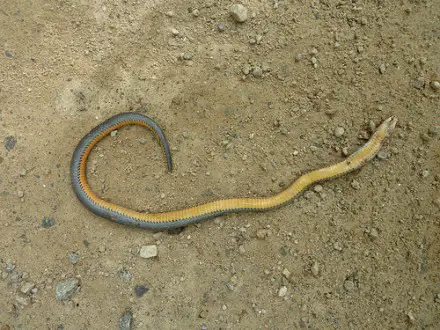A Southern or northern Ringneck snake are small, measuring only about 25" 38 cm, which are blackish grey in colour. Northern Ringneck snakes (Diadophis punctatus edwardsi) inhabits the mountains and generally has a complete yellow or orange ring around its neck with a yellow belly. While a southern Ringneck snake is found in coastal areas and often as a broken ring around its neck and its underside is yellow but spotted with black spots.
The Ringneck snake has one of the largest geographic ranges of any species of snake in North America. Ringnecks are found throughout the eastern two thirds of the United States from southern Canada to Florida, across the desert southwest and along most of the Pacific coast. Ringnecks are found throughout Georgia and South Carolina with the northern subspecies inhabiting the mountains and the southern subspecies being found in the Coastal Plain. Ringnecks from the Piedmont are intergrades between the two races.
Ringneck snakes can be found in virtually any habitat but seem to prefer wooded areas. In the Piedmont and Coastal Plain Ringnecks are particularly common in moist areas including river floodplains, moist hardwood forests, and wetland edges. In mountainous regions Ringnecks are often found in more open habitats where they frequently take refuge under rocks.
Like other small woodland snakes, Ringnecks spend most of their time underground or hidden under logs, rocks or other debris. Ringnecks are one of the more common species and their numbers can reach to extraordinary densities in certain areas. As part of his famous long-term mark-recapture snake studies in Kansas, Henry Fitch estimated that Ringneck snakes exist at densities greater than 700 - 1800 per hectare (2.47 acres). Due their abundance, Ringnecks play an important ecological role as intermediate predators in their community food webs, functioning as both predator and prey.
Although they are completely harmless to humans, Ringnecks have weak venom in their saliva which they use to subdue their prey, which include amphibians, lizards and other small snakes. Ringneck snakes mate in the fall and females lay around 2-7 eggs in the early summer.
The Ringneck snake has one of the largest geographic ranges of any species of snake in North America. Ringnecks are found throughout the eastern two thirds of the United States from southern Canada to Florida, across the desert southwest and along most of the Pacific coast. Ringnecks are found throughout Georgia and South Carolina with the northern subspecies inhabiting the mountains and the southern subspecies being found in the Coastal Plain. Ringnecks from the Piedmont are intergrades between the two races.
Ringneck snakes can be found in virtually any habitat but seem to prefer wooded areas. In the Piedmont and Coastal Plain Ringnecks are particularly common in moist areas including river floodplains, moist hardwood forests, and wetland edges. In mountainous regions Ringnecks are often found in more open habitats where they frequently take refuge under rocks.
Like other small woodland snakes, Ringnecks spend most of their time underground or hidden under logs, rocks or other debris. Ringnecks are one of the more common species and their numbers can reach to extraordinary densities in certain areas. As part of his famous long-term mark-recapture snake studies in Kansas, Henry Fitch estimated that Ringneck snakes exist at densities greater than 700 - 1800 per hectare (2.47 acres). Due their abundance, Ringnecks play an important ecological role as intermediate predators in their community food webs, functioning as both predator and prey.
Although they are completely harmless to humans, Ringnecks have weak venom in their saliva which they use to subdue their prey, which include amphibians, lizards and other small snakes. Ringneck snakes mate in the fall and females lay around 2-7 eggs in the early summer.

